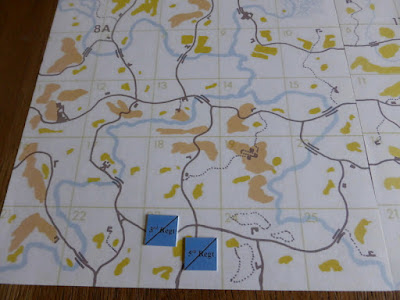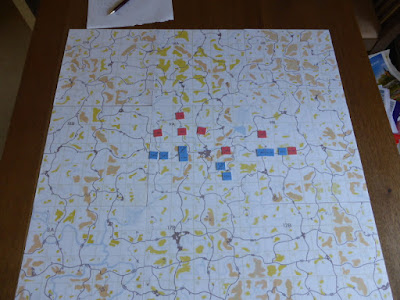The sudden death of the ruler of Rhabarberia had left a problem in the local geo-politics of this part of Mittel Europa. The heir, Prinz Rupert, was not yet of an age to assume the throne and frankly spent most of his time asking Mummy where his chin was. With the two main powers in the region locked in battle in the Austro-Prussian War, the Elector of Prusskia and the Grand-Duke of Ruthenia both saw an opportunity to annexe the Principality of Rhabarberia.
A certain enmity existed between the two States as the Elector hated rhubard, the main export from Rhabarberia, whilst the Grand-Duke liked nothing better to go with his custard. Wishing to protect the lucrative rhubard fields, the Ruthenian Army advanced in to Rhabarberia whilst it helped Prinz Rupert find his chin. The Prusskian Army could not stand idly by and so also advanced, under the guise of protecting Rhabarberian independence, but with the real aim of replacing the rhubard fields with some nice cabbage.
With the broad mechanics of the campaign sorted and the players briefed, it was time to kick things off. Each player gave me a broad guide to their intentions, which can be seen below.
The Army of the Elector of Prusskia (Red)
The Army of the Grand-Duke of Ruthenia (Blue)
Strong centre, outflanking on the right, cavalry diversion on the left.
A certain enmity existed between the two States as the Elector hated rhubard, the main export from Rhabarberia, whilst the Grand-Duke liked nothing better to go with his custard. Wishing to protect the lucrative rhubard fields, the Ruthenian Army advanced in to Rhabarberia whilst it helped Prinz Rupert find his chin. The Prusskian Army could not stand idly by and so also advanced, under the guise of protecting Rhabarberian independence, but with the real aim of replacing the rhubard fields with some nice cabbage.
With the broad mechanics of the campaign sorted and the players briefed, it was time to kick things off. Each player gave me a broad guide to their intentions, which can be seen below.
The Army of the Elector of Prusskia (Red)
Standing general Divisional actions on meeting enemy:
-
If enemy forces are met, cavalry to chase off enemy light screens. Aggression to be applied to this.
-
Light infantry to always be in lead elements of Division to move forward and assist cavalry. Aggression to be applied to this.
-
1st Brigade to Deploy in order to hold current position until enemy can be driven off. Use artillery to chase off enemy.
-
On completion of clearing enemy continue to forward movement.
-
If main body is met, deploy to engage and win fire fight with all available firepower.
-
Be prepared to take advantage of weak flanks.
-
Bull horns, then main body.
The Army of the Grand-Duke of Ruthenia (Blue)
Strong centre, outflanking on the right, cavalry diversion on the left.
insert keith and daves starting orders/plans here.
Starting Positions
Starting Positions
Each player was asked for their starting positions and first Turn orders of movement. I then simply applied them to the map and moved them to fit in with their orders according to the terrain and their standing orders. Once the moves had been completed, I then updated the players on their troops positions (which did not always correspond to their orders) as well as showing them 'photos and, where appropriate, enemy troops positions. This maintained a true fog of war in the early Turns and as they made contact, more was revealed. Good use of cavalry screens was crucial as not only did it allow the commander to 'see' the enemy, but it also blocked the enemy's view to troops behind the screen etc.
End of Turn 1
Both sides advance as per their orders, with the road network favouring the Ruthenians at this point.
End of Turn 2
Cavalry from both sides approaches the capital, Offenburgh, whilst the infantry is still someway back.
Turn 3
As the cavalry started to see enemy troops, the fog of war lifted somewhat, allowing the respective commanders to concentrate their forces as they saw fit. This Turn saw the first engagement, with cavalry meeting to the East of the capital, Offenburgh.
An AAR of the cavalry clash can be found here. The aftermath of the cavalry clash can be seen below.
Turn 4
Both sides manouevred for position and as they did so, the Prusskian 5th Division caught a detached Brigade from the Ruthenian 2nd Division by surpise as they advanced to the East of Offenburgh.
So this latest battle will be fought over the next day or so and the outcome may or may not have a big influence on the overall campaign.
Campaign Thoughts So Far
I thought I'd jot down some notes on how the campaign has gone so far:
End of Turn 2
Cavalry from both sides approaches the capital, Offenburgh, whilst the infantry is still someway back.
Turn 3
As the cavalry started to see enemy troops, the fog of war lifted somewhat, allowing the respective commanders to concentrate their forces as they saw fit. This Turn saw the first engagement, with cavalry meeting to the East of the capital, Offenburgh.
 |
| The Prusskian cavalry outnumbers the Ruthenian cavalry. |
An AAR of the cavalry clash can be found here. The aftermath of the cavalry clash can be seen below.
Turn 4
Both sides manouevred for position and as they did so, the Prusskian 5th Division caught a detached Brigade from the Ruthenian 2nd Division by surpise as they advanced to the East of Offenburgh.
 |
| Both Armies surround Offenburgh, which has closed its gates to both sides. |
 |
| The action is about to get interesting to the East of Offenburgh. |
So this latest battle will be fought over the next day or so and the outcome may or may not have a big influence on the overall campaign.
Campaign Thoughts So Far
I thought I'd jot down some notes on how the campaign has gone so far:
- Ideally it would be good to have the map permanently set up somewhere, so you don't have to keep re-positioning the counters each Turn. Sadly I don't have such a space.
- When setting out the maps squares, it is important to have a good look at how the road network works in terms of movement etc. Also are the rivers fordable or not, how hilly is the terrain and what effects, if any, might this have on troop movement. I sort of did this when chossing the squares, but would pay more attention next time.
- With the fog of war early on, using your cavalry to scout ahead is an absolute must. With my God like overview, it is interesting to see the orders each Turn and what might unfold when they can 'see' each other.
- Make sure you have plenty of counters that cover various situations, such as detached troops etc. I had some but need more at am currently noting this on my master sheet as it were.
- You have to interpret both sides orders as best you can when making simultaneous movement and naturally try to be fair and even handed to both sides. Some are easy to do than others, especially when a battle might ensue. So I think what would logically happen given the orders received, the terrain being moved over and the presense of the enemy.
- Try and give some intel to both sides, especially in the early Turns when they are quite far apart, to aid them in manouevering towards the enemy. Afterall if is no fun for the players if they spend 10 Turns wandering around the countryside! This can take any form you fancy, but I went along the lines of 'enemy cavalry has been spotted a days march from Offenburgh'. Enough to be useful but not so detailed as to provide unrealistic intel.
- Keep the campaign area to a size that allows for some early manouevring, but also means both sides begin to make contact after 2-3 Campaign Turns. With my movement rates, I found a 3x3 square grid perfect for this.


































Very good. I like the way that cavalry get a truer role with their screening capability.
ReplyDeleteI really liked the cavalry action in the separate post and have commented there ...” Lovely little action, the blocks look very good and the Turn 2 blunder was an excellent bit of chaos.”
Thanks Norm. Cavalry are all too often neglected in mid-19thC games, so it is nice to have them doing what they did historically.
DeleteGood to see cavalry performing a proper role in your campaign. As you mention, recce and screening is not often seen on the gaming table. I see this role in board wargames but rarely on the Miniatures table.
ReplyDeleteI think the campaign aspect allows the players to use the cavalry in their historical role, which is nice: afterall the map moves are almost like a boardgame. Normally both sides are deployed and the cavalry is noticeable by its absence.
DeleteHowever in games such as Bloody Big Battles or Bruce Weigle's rules, cavalry can be on the table and rather effective too.
Steve, I don't recall if you are a board wargamer too but AH's operational Napoleonic campaign, "Struggle of Nations" used a clever mechanism that allowed cavalery detachments to perform their historical role in recce, screening, pinning enemy forces, as well as battle cavalry. Quite clever and worked well.
DeleteWeigle's rules are a real asset to 19th Century gaming even if one never plays the rules!
Not a board gamer yet, but am increasingly tempted, often by Norm's excellent reports. The 'Struggle of Nations' sounds good and the sort of game I would like. Too may things to tempt a poor soul like me!
DeleteBruce's books are a superb resource for 19thC gamers of the 1859 - 1871 period. He's also a terribly nice chap.
Top report, thank you.
ReplyDeleteYou're welcome Will.
Delete